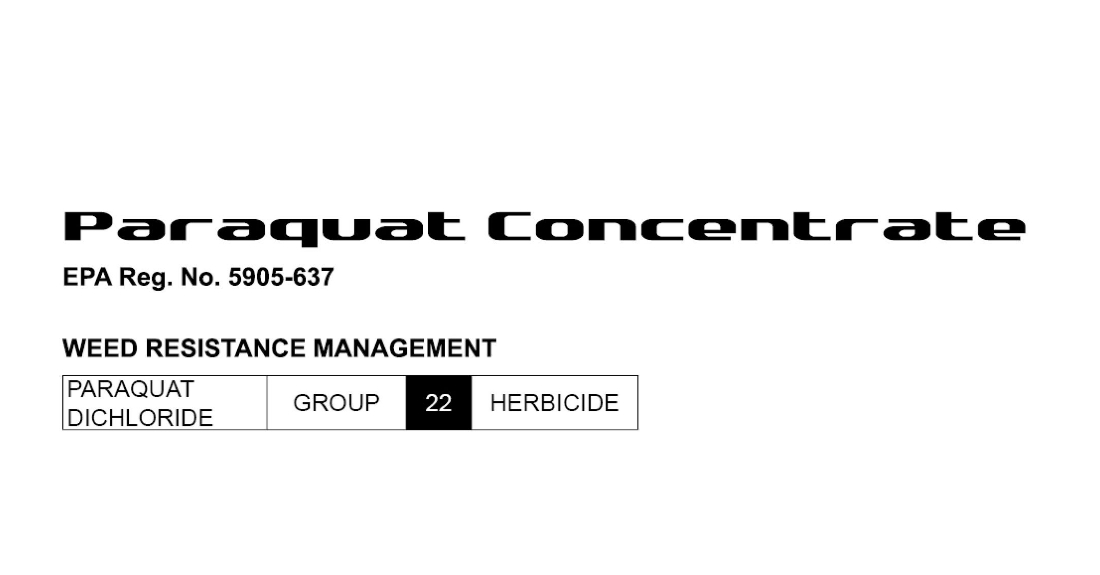
This product contains paraquat dichloride and is classified as a Group 22 herbicide, chemical class bipyridylium, with photosystem l electron diverter mode of action. Herbicide resistance is defined as the inherited ability of a plant to survive and reproduce following exposure to a dose of herbicide normally lethal to the wild type. In a plant, resistance may be naturally occurring or induced by such techniques as genetic engineering or selection of variants produced by tissue culture or mutagenesis. Any weed population may contain or develop plants that are naturally resistant to this product and other Group 22 herbicides. Weed species with acquired resistance to Group 22 herbicides may eventually dominate the weed population if Group 22 herbicides are used repeatedly in the same field or in successive years as the primary method of control for target species. This may result in partial or total loss of control of those species by this product or other Group 22 herbicides.
Indicators of possible herbicide resistance include: (1) failure to control a weed species normally controlled by the herbicide at the dose applied, especially if control is achieved on adjacent weeds; (2) a spreading patch of non-controlled plants by a particular weed species; (3) surviving plants mixed with controlled individuals of the same species. If resistance is suspected, prevent weed seed production in the affected area by an alternative herbicide from a different group or by a non-chemical method such as hoeing or tillage. Prevent movement of resistant weed seeds to other fields by cleaning harvesting and tillage equipment when moving between fields, and planting clean seed. If a weed pest population continues to progress after treatment with this product, discontinue use of this product, and switch to another management strategy or herbicide with different mode of action, if available.
To delay herbicide resistance take one or more of the following steps:
- Rotate the use of (name of product) or other Group (mode of action group number) herbicides within a growing season sequence or among growing seasons with different herbicide groups that control the same weeds in a field.
- Use tank mixtures with herbicides from a different group if such use is permitted; where information on resistance in target weed species is available, use the less resistance-prone partner at a rate that will control the target weed(s) equally as well as the more resistance-prone partner. Consult your local extension service or certified crop advisor if you are unsure as to which active ingredient is currently less prone to resistance.
- Adopt an integrated weed-management program for herbicide use that includes scouting and uses historical information related to herbicide use and crop rotation, and that considers tillage ( or other mechanical control methods), cultural ( e.g., higher crop seeding rates; precision fertilizer application method and timing to favor the crop and not the weeds), biological (weed-competitive crops or varieties) and other management practices.
- Scout after herbicide application to monitor weed populations for early signs of resistance development. Indicators of possible herbicide resistance include: (1) failure to control a weed species normally controlled by the herbicide at the dose applied, especially if control is achieved on adjacent weeds; (2) a spreading patch of non-controlled plants of a particular weed species; (3) surviving plants mixed with controlled individuals of the same species. If resistance is suspected, prevent weed seed production in the affected area by an alternative herbicide from a different group or by a mechanical method such as hoeing or tillage. Prevent movement of resistant weed seeds to other fields by cleaning harvesting and tillage equipment when moving between fields, and planting clean seed.
- If a weed pest population continues to progress after treatment with this product, discontinue use of this product, and switch to another management strategy or herbicide with a different mode of action, if available.
- Contact your local extension specialist or certified crop advisors for additional pesticide resistance-management and/or integrated weed-management recommendations for specific crops and weed biotypes.
- For further information or to report suspected resistance, please contact registration@helenaagri.com.
